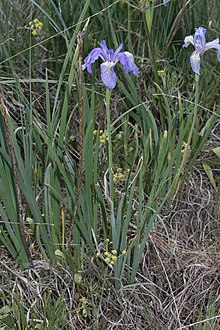Iris missouriensis
| Iris missouriensis | |
|---|---|

| |
| Iris missouriensis (Wenas Wildlife Area, Washington) | |
| Scientific classification | |
| Kingdom: | |
| (unranked): | |
| (unranked): | |
| Order: | |
| Family: | |
| Subfamily: | |
| Tribe: | |
| Genus: | |
| Subgenus: | |
| Series: | |
| Species: | I. missouriensis
|
| Binomial name | |
| Iris missouriensis | |
| Synonyms | |
| |
Iris missouriensis (syn. I. montana) is a hardy flowering rhizomatous species of the genus Iris, in the family Iridaceae. Its common names include western blue flag, Rocky Mountain iris, and Missouri flag.
It is native to western North America. Its distribution is varied; it grows at high elevations in mountains and alpine meadows and all the way down to sea level in coastal hills.[2][3]
Description

Iris missouriensis is an erect herbaceous rhizomatous perennial, 20 to 40 cm high, with leafless unbranched scapes (flowering stems) and linear basal leaves, 5 to 10 mm wide, similar in height to the scapes. The inflorescence usually consists of one or two flowers, exceptionally three or four. Each flower has three light to dark blue, spreading or reflexed sepals lined with purple and three smaller upright blue petals.[4][5][6][7]
Uses
Some Plateau Indian tribes used the roots to treat toothache.[8]
The Navajo used a decoction of this plant as an emetic.[9] The Zuni apply a poultice of chewed root to increase strength of newborns and infants.[10]
This iris is listed as a weed in some areas, particularly in agricultural California. It is bitter and distasteful to livestock and heavy growths of the plant are a nuisance in pasture land. Heavy grazing in an area promotes the growth of this hardy iris.[6]
The plant is widely cultivated in temperate regions[11]
References
- ^ "Iris missouriensis Nutt. is an accepted name". theplantlist.org. 23 March 2012. Retrieved 3 November 2014.
- ^ Sullivan, Steven. K. (2015). "Iris missouriensis". Wildflower Search. Retrieved 2015-06-16.
- ^ "Iris missouriensis". PLANTS Database. United States Department of Agriculture; Natural Resources Conservation Service. 2015. Retrieved 2015-06-16.
- ^ Klinkenberg, Brian (Editor) (2014). "Iris missouriensis". E-Flora BC: Electronic Atlas of the Plants of British Columbia [eflora.bc.ca]. Lab for Advanced Spatial Analysis, Department of Geography, University of British Columbia, Vancouver. Retrieved 2015-06-16.
{{cite web}}:|first=has generic name (help) - ^ Giblin, David (Editor) (2015). "Iris missouriensis". WTU Herbarium Image Collection. Burke Museum, University of Washington. Retrieved 2015-06-16.
{{cite web}}:|first=has generic name (help) - ^ a b "Iris missouriensis". Jepson eFlora: Taxon page. Jepson Herbarium; University of California, Berkeley. 2015. Retrieved 2015-06-16.
- ^ http://www.fs.fed.us/wildflowers/beauty/iris/blueflag/iris_missouriensis.shtml
- ^ Hunn, Eugene S. (1990). Nch'i-Wana, "The Big River": Mid-Columbia Indians and Their Land. University of Washington Press. p. 354. ISBN 0-295-97119-3.
- ^ Peter Goldblatt. 1980. Uneven Diploid Chromosome Numbers and Complex Heterozygosity in Homeria (Iridaceae). Systematic Botany, Vol. 5, No. 4, pp. 337-340
- ^ Camazine, Scott and Robert A. Bye 1980 A Study Of The Medical Ethnobotany Of The Zuni Indians of New Mexico. Journal of Ethnopharmacology 2:365-388 (p. 373)
- ^ "RHS Plant Selector - Iris missouriensis". Retrieved 24 June 2013.
External links
 Media related to Iris missouriensis at Wikimedia Commons
Media related to Iris missouriensis at Wikimedia Commons Data related to Iris missouriensis at Wikispecies
Data related to Iris missouriensis at Wikispecies- UC Photos gallery — Iris missouriensis
